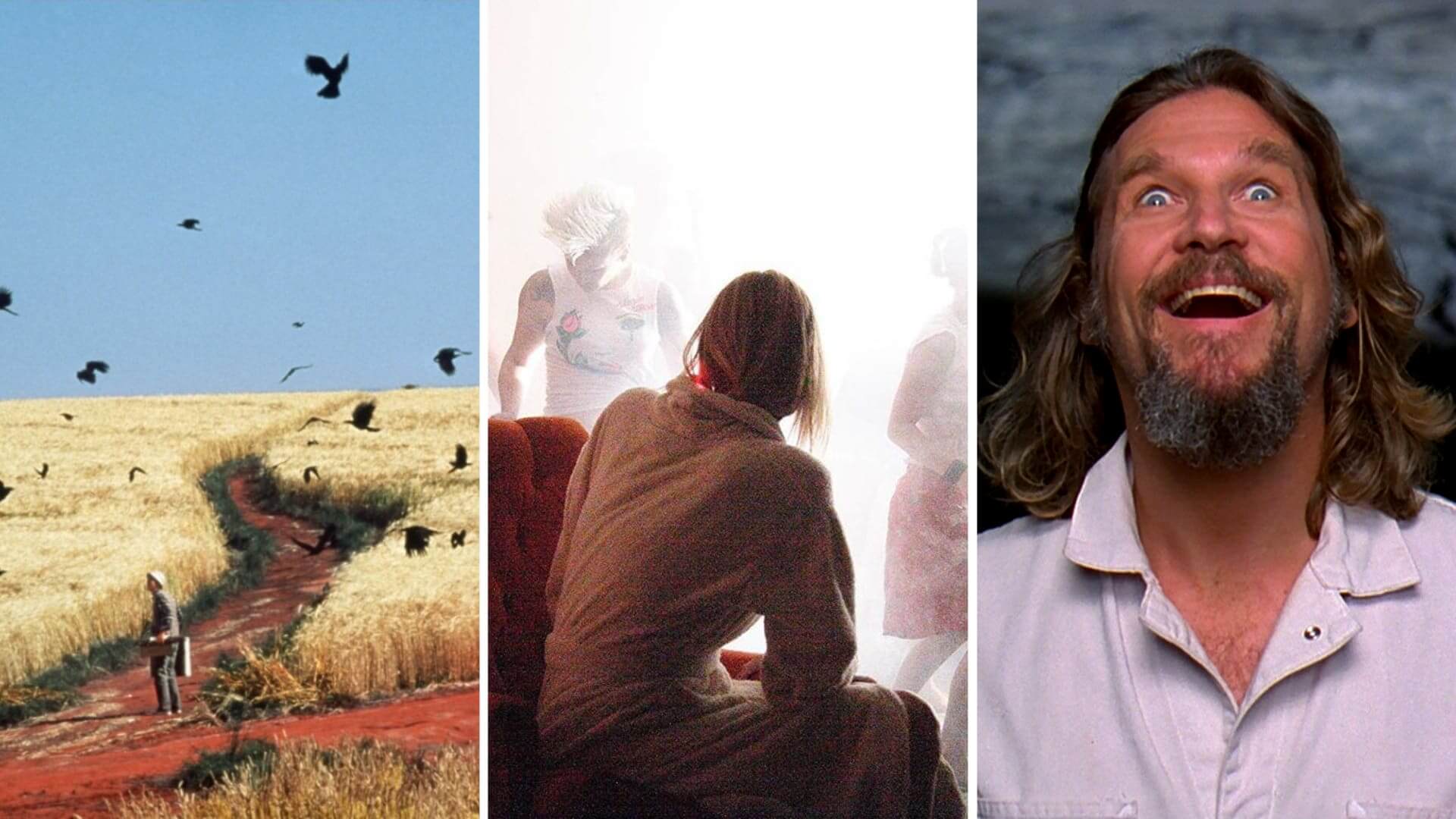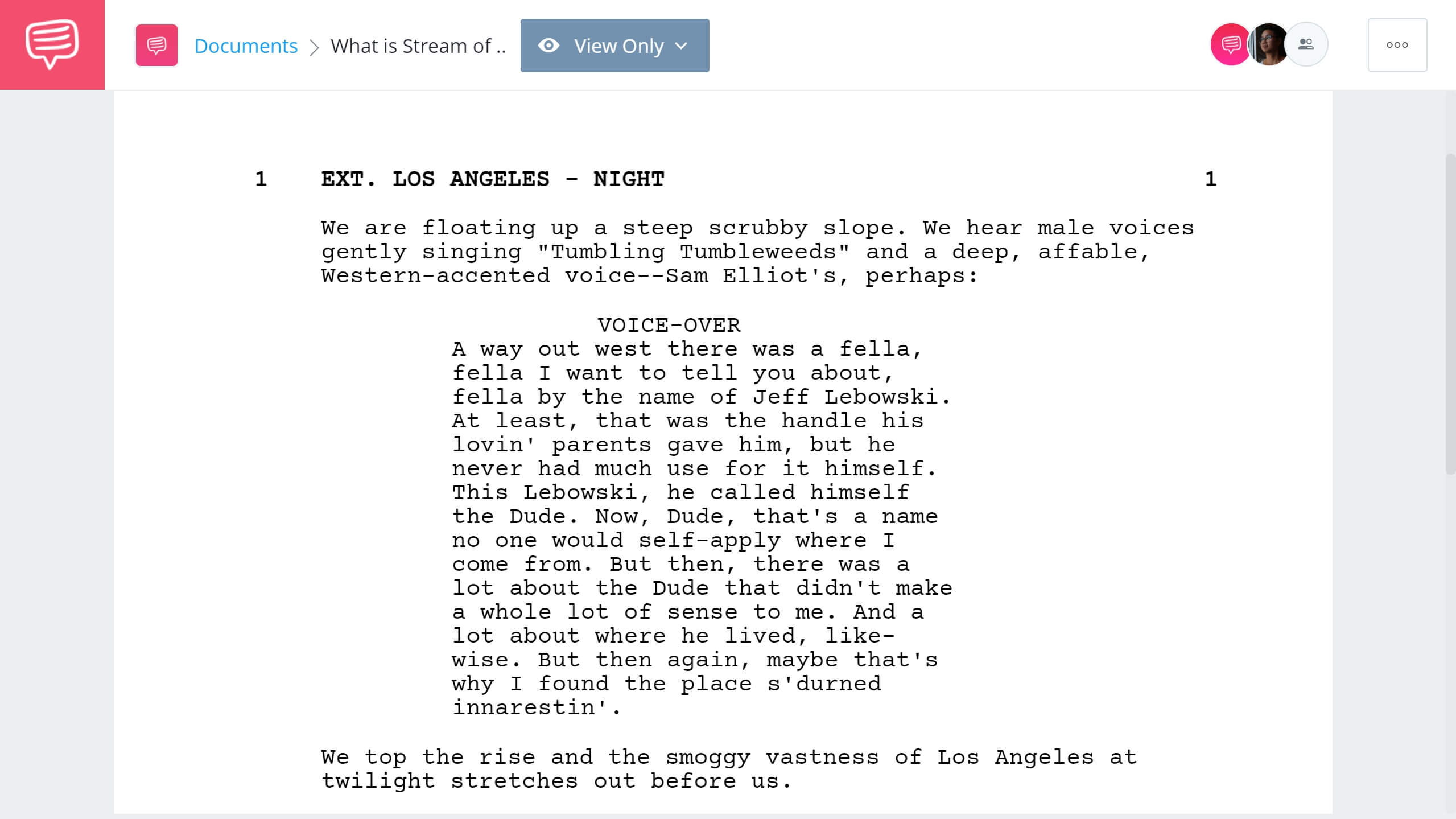As a writer, stream of consciousness may be fun to write but unenjoyable to read. Or for you, the reverse may be true. When talking about screenwriting, stream of consciousness may not be a method frequently used on the page but can be used and benefited from in the pre-writing process or even with visual elements on screen. This article will answer what is stream of consciousness writing by providing narrative examples and film examples, while also demonstrating another use of the method to help screenwriters (or any writer) connect to their best work.
Defining Stream of Consciousness
Stream of consciousness definition
So, what exactly do we mean by stream of consciousness? Well, if we can get a little "heady" on you, let's break it down. Try to think of your brain activity as constantly moving forward, like a car on a road or, hey, an actual stream!
But for this analogy, let's stick with the car.
When we sit down to write, especially any sort of narrative, there is a lot of "starting" and "stopping." We think of one line and we write it down (the car goes forward) but then we stop to think about what the next line should be (the car stops). Therefore, a typical way to write is like mental rush-hour traffic, where the flow of ideas are constantly interrupted, considered, planned, etc.
Stream of consciousness writing is a wide-open highway where your mental car can drive at full speed with nothing to block or detour ideas.
Now, hopefully that analogy made sense but just in case it didn't, here's a more formal stream of consciousness definition.
Stream of Consciousness Definition
What is stream of consciousness writing?
Stream of consciousness writing is a method of writing that captures the myriad of thoughts and feelings that pass through the mind. This method’s purpose is to allow these thoughts to pass through without any inhibitors. It’s quite literally capturing the “stream” of your consciousness.
Stream of consciousness vs internal monologue
- Internal monologue is logical and often linear. Thoughts coherently move from one to the next.
- Stream of consciousness writing is often non-linear, characterized by nontraditional grammar and syntax.
Let's move on to discuss more of the benefits of stream of consciousness writing and look at some more examples from literature and film in detail.
Why is This Important?
Benefits of stream of consciousness writing
Because of its cerebral nature, stream of consciousness writing is great for writing about consciousness or as different consciousnesses. What does that mean? It lets the writer explore and write to a truer experience, one that is more reflective of what’s happening inside the mind. This kind of practice would be good for writing about a drug experience, a hallucination, or even describing a dream world or some other trance-like state.
The reason it’s used in narratives and films alike, is to make the viewer or the reader truly experience those thoughts as the character is thinking them. It doesn’t just relay thoughts to the audience for informational purposes, but creates an experience of thinking.
Stream of consciousness writing isn’t just for the narrative. It is also a brainstorming technique to encourage creativity and intuitive writing. This can be especially helpful for writer’s block.
Stream of Consciousness Examples
Use stream of consciousness in movies
In film, stream of consciousness isn’t always used as a writing technique, but instead may express itself in the visual elements on screen.
Let’s consider David Lynch.
Lynch comes to mind as the majority of his films could be considered a kind of stream of consciousness. Let’s look at one in particular...Inland Empire.
Laura Dern’s character, Nikki, is an actress who gets lost in her new role. Her real self and the character she’s playing start to blend into one. Aside from the distorted cinematography, the film focuses on the subjectivity of Nikki’s experiences. It goes from one hallucination to the next that feels more like an association than logical plot structure.
Whether you enjoyed this nightmarish drama or not, it’s a true experience of stream of consciousness using visual elements, auditory elements, and scene by scene surrealism as a way to show the character’s perception. The audience experiences the messiness that is her mind.
You could understand this without ever hearing David Lynch explain the film. But even more fascinating is how the filmmaker’s stream of consciousness helped create the film.
Caption: Lynch’s stream of consciousness process
In the video above, he talks about his usual process — how when he gets an idea, he writes it down little-by-little, and eventually, it turns into a script. With Inland Empire, he explains his process as writing an idea down, then going right out to shoot it. Getting another idea, and then going to shoot it. He states he didn’t have a clue of how one idea was related to the other.
In this case, his entire filmmaking process for this film could be considered stream of consciousness! Which, because we’re talking about David Lynch, may not actually come as a surprise to most of us, but perhaps gives more clarity to how and why the movie unfolded the way it did.
Stream of consciousness writing examples in a screenplay
And of course, screenplays can have stream of consciousness in their dialogue or voiceover, but it’s not as common. It’s not as common because most of the time when a character is going on some tangent, it’s considered an inner monologue. Keep in mind, an internal monologue is different than stream because it follows a coherent path — often linear, going from one thought to the next, even if it appears as rambling.
And these monologues are in a ton of scripts.
But that being said, there are examples in cinema that do use stream of consciousness in the actual script.
The voiceovers in The Big Lebowski border on stream of consciousness. Often going from one thought to the next with unconventional grammar, syntax and heavy use of association. To be fair, the associations are fairly logical in instances but this is interspersed with dream sequences that are absolutely stream of consciousness.
Stream of Consciousness Example in The Big Lebowski • Read Full Scene
But before the movies, this technique was used as a way to describe and dissect literature in the early 20th century.
Stream of Consciousness Examples
Using stream of consciousness in fiction
Stream of consciousness is most common in fiction. Novels are longer winded mediums than anything else and this kind of writing can be used to not only reveal thoughts of a character but reveal the inner workings of their mind.
The first time this psychological term was used in a literary sense was by May Sinclaire in 1915, when she was reviewing Dorothy Richardson’s Pointed Roofs.
“On one side was the little grey river, on the other long wet grass repelling and depressing. Not far ahead was the roadway which led, she supposed to the farm where they were to drink new milk. She would have to walk with someone when they came to the road, and talk. She wondered whether this early morning walk would come, now, every day. Her heart sank at the thought.”
Virginia Woolf uses stream of consciousness throughout the iconic Mrs. Dalloway:
“Her only gift was knowing people almost by in-stinct, she thought, walking on. If you put her in a room with some one, up went her back like a cat's; or she purred. Devonshire House, Bath House, the house with the china cockatoo, she had seen them all lit up once; and remembered Sylvia, Fred, Sally Seton-such hosts of people; and dancing all night; and the waggons plodding past to market; and driving home across the Park. She remembered once throwing a shilling into the Serpentine. But every one remembered; what she loved was this, here, now, in front of her; the fat lady in the cab. Did it matter then, she asked herself, walk-ing towards Bond Street, did it matter that she must in-evitably cease completely; all this must go on without her; did she resent it; or did it not become consoling to believe that death ended absolutely?”
Woolf takes us through this paragraph of past people and places, through means of nostalgic associations.
Brainstorming Tips for Screenwriters
Stream of consciousness brainstorming
In screenwriting, stream of consciousness writing doesn’t happen on the page per se. While it can be voiceover or dialogue, generally speaking, you won’t want to go on tangents in the confines of a visual medium.
But that being said, the most powerful brainstorming tool for a screenwriter, or really for any writer, is stream of consciousness pre-writing.
Because stream of consciousness writing is often long-winded, lacking structure, it may seem unorganized. But there is still organization there.
Stream of consciousness is the result of the way your brain is naturally ordering its thoughts, feelings, and all of the energy in between. This is powerful. Trust it. Deeper patterns appear.
Ones that are harder to access when you’re obsessively thinking about plot, theme, and character. This is what people refer to as flow state. Use it!
Let’s write!
With stream of consciousness brainstorm writing, we don’t stop or hesitate. We just write without objectively thinking about what to put on the page.
So rather than just free writing, here are some stream of consciousness writing exercises you can try to help discover more about your characters.
Set a timer and just go for it.
- You can start with how you’re feeling or if you’re thinking of a character you started creating...what if they felt this way?
- You’re at a party — what’s going on, who do you run into, who do you avoid?
- Imagine your character is on a sailboat with 10 plus people. They suddenly recognize someone on the boat. Who is it?
Keep in mind, these just become regular writing prompts if you think too much about them. The goal here is to get into the flow of your natural thoughts, free of all ideas about those thoughts.
Don’t hesitate and just keep writing until that timer goes off!
UP NEXT
Creative Writing Prompts
If you’re feeling up for it and want to practice more stream of consciousness, give the next post a try. We’ve provided over 80 prompts, that will help get you into that flow state!

